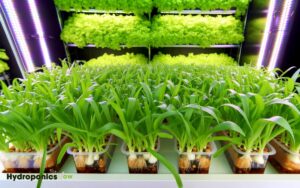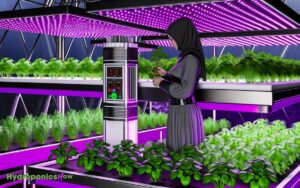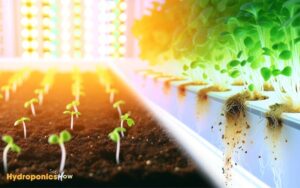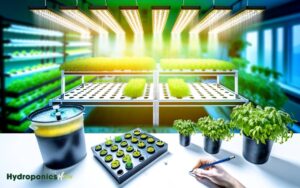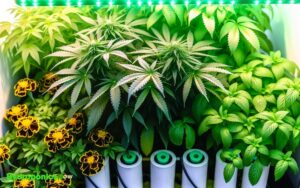How Does a Hydroponic System Help Keep a Plant Alive?
A hydroponic system keeps your plants alive by delivering precise nutrient solutions directly to the roots, balanced for peak growth. It efficiently conserves water by recirculating and minimizing waste.
Enhanced oxygenation prevents root suffocation, ensuring robust plant health. Disease prevention and pest control are maintained with controlled water quality and biological treatments.
Regulated temperature and humidity create an ideal growing environment, while pH and nutrient levels are consistently monitored.
Without the need for soil, you have complete control over all growth factors, resulting in healthy, thriving plants. For a deeper understanding, continue exploring the sophisticated methods involved.

Key Takeaways
Nutrient Delivery
In a hydroponic system, nutrient delivery is a critical process where plants receive a balanced solution of water and essential minerals directly to their roots.
You must guarantee the nutrient solution contains the right concentrations of nitrogen, phosphorus, potassium, and trace elements. This balance is crucial for best growth and development.
Using a controlled delivery mechanism, like drip emitters or nutrient film technique (NFT), you can regulate the flow of nutrients to the root zone.
It’s important to monitor pH levels and electrical conductivity (EC) regularly, as these parameters affect nutrient uptake.
Water Conservation
You’ll find that hydroponic systems maximize water conservation through efficient water usage and reduced evaporation loss.
By employing precise watering control, these systems guarantee plants receive the exact amount of water needed, minimizing waste.
This approach not only conserves water but also optimizes plant health and growth.
Efficient Water Usage
A hydroponic system greatly reduces water waste by recirculating nutrient solutions directly to the plant roots. This closed-loop method guarantees that every drop of water is utilized efficiently.
Using sensors, you can precisely monitor and adjust the nutrient balance, maintaining ideal conditions for plant growth. Unlike traditional soil-based methods, hydroponics minimizes runoff and leaching, conserving water resources.
The system’s design allows for targeted delivery of water and nutrients, reducing the need for excess water. Additionally, the absence of soil reduces the potential for water loss through evaporation and percolation.
Reduced Evaporation Loss
Hydroponic systems drastically reduce evaporation loss by confining water and nutrient solutions within enclosed environments. This setup minimizes water exposure to air, curbing evaporation to a large extent.
Here’s how it works:
- Enclosed Reservoirs: By storing water in covered tanks, you prevent direct contact with air, reducing evaporation rates.
- Recirculating Systems: These systems continuously cycle water, ensuring minimal exposure to evaporative conditions.
- Humidity Control: Enclosed systems maintain higher humidity levels, further decreasing water loss through evaporation.
- Root Zone Isolation: By containing the root zone within a closed environment, you limit the surface area available for evaporation.
Precise Watering Control
By utilizing precise watering control, hydroponic systems optimize water usage, ensuring plants receive exact amounts to thrive without waste.
You’ll benefit from sensors and automated systems that monitor moisture levels in real-time. These technologies adjust water delivery based on the plant’s needs, eliminating overwatering or underwatering.
This method conserves water and provides a consistent nutrient supply, enhancing plant growth and health. Hydroponic systems use closed-loop irrigation, recycling water within the system, which reduces overall water consumption.
You’ll find this especially beneficial in arid environments or regions with limited water resources.
Root Oxygenation
Root oxygenation is essential in hydroponic systems because it guarantees improved oxygen delivery directly to the plant roots.
You must prevent root suffocation to maintain ideal growth conditions and avoid anaerobic conditions that harm the plant.
Enhanced Oxygen Delivery
Increasing oxygen availability to the root zone greatly enhances nutrient uptake efficiency and overall plant health in hydroponic systems. Oxygen plays a pivotal role in root respiration, a process essential for converting nutrients into usable forms.
In hydroponic systems, you can achieve superior oxygen delivery through several methods:
- Air Stones: These devices diffuse air into nutrient solutions, ensuring continuous oxygen availability.
- Water Pumps: By circulating the nutrient solution, water pumps prevent stagnation and increase oxygen exposure to roots.
- Oxygen-Rich Nutrient Solutions: Incorporating hydrogen peroxide or specialized oxygenating compounds can boost dissolved oxygen levels.
- Aquaponics Integration: Combining hydroponics with aquaponics can naturally enhance oxygenation through biological processes.
These techniques guarantee that your plants receive optimal oxygen levels, promoting robust growth and superior yields.
Preventing Root Suffocation
Guaranteeing sufficient root oxygenation is crucial in hydroponic systems to avoid root suffocation and maintain ideal plant health.
In hydroponics, roots are submerged in nutrient solutions, which can limit oxygen availability. To counteract this, you need to use air pumps and air stones to aerate the solution. This process introduces dissolved oxygen (DO) into the water, which roots absorb efficiently.
High DO levels facilitate cellular respiration in root tissues, promoting energy production and nutrient uptake. Additionally, maintaining an ideal temperature (18-22°C) helps increase oxygen solubility in water.
Promoting Root Health
To maintain robust plant growth in hydroponic systems, you must focus on optimizing root oxygenation to guarantee effective cellular functions and nutrient absorption.
Proper oxygenation ensures that roots can efficiently perform aerobic respiration, which is important for energy production. By enhancing root oxygenation, you improve nutrient uptake and overall plant health.
Here are four key strategies:
- Aeration Systems: Use air stones or diffusers to introduce dissolved oxygen into the nutrient solution.
- Water Temperature Control: Maintain temperatures between 18-22°C (64-72°F) to maximize oxygen solubility.
- Hydroponic Media: Choose media like perlite or clay pellets that allow better air circulation.
- Regular Monitoring: Frequently check dissolved oxygen levels with a DO meter to ensure they remain at an ideal level.
Implementing these techniques will greatly enhance root health and plant vitality.
Disease Prevention
Preventing disease in a hydroponic system requires meticulous monitoring of water quality and nutrient levels to guarantee plant health at its best. You need to make sure that water remains free of pathogens by utilizing UV sterilization or ozonation.
Regularly test and adjust pH levels, as imbalances can stress plants and make them susceptible to diseases. Employing a recirculating system can help, but you must replace the nutrient solution periodically to avoid nutrient lockout and pathogen buildup.
Additionally, using beneficial microbes can outcompete harmful organisms, creating a healthier root environment. Sanitation is also vital; sterilize equipment and grow mediums to prevent cross-contamination.
Pest Control
Combatting pests in a hydroponic system demands a multifaceted approach that integrates physical barriers, biological controls, and chemical treatments to safeguard plant health and yield. You’ll need to implement a systematic strategy to effectively manage pest populations.
- Physical Barriers: Utilize screens and covers to prevent insect entry while maintaining airflow and light penetration.
- Biological Controls: Introduce beneficial insects like ladybugs and predatory mites to naturally reduce pest populations without harming your plants.
- Chemical Treatments: Apply organic insecticides and fungicides sparingly to target specific pests without disrupting the ecosystem balance.
- Environmental Monitoring: Regularly monitor temperature, humidity, and nutrient levels to create conditions less favorable for pests, thereby enhancing plant resilience.
Faster Growth Rates
You’ll notice faster growth rates in hydroponic systems due to optimized nutrient delivery, which guarantees plants receive essential minerals in precise quantities.
Controlled environment conditions, such as temperature and humidity, allow for year-round cultivation without seasonal constraints.
Additionally, efficient water usage minimizes waste and maximizes hydration, promoting rapid and robust plant development.
Optimized Nutrient Delivery
Maximized nutrient delivery in hydroponic systems guarantees faster growth rates by providing plants with a precise and balanced mix of essential minerals directly to their root zones.
This method assures plants receive ideal levels of nutrients, which greatly enhances their growth efficiency.
Here’s how optimized nutrient delivery contributes to faster growth:
- Nutrient Absorption Efficiency: Roots absorb nutrients faster and more efficiently in a hydroponic setup, eliminating nutrient competition.
- Customizable Nutrient Solutions: Tailor the nutrient mix to meet specific plant needs, promoting overall health and accelerated growth.
- Consistent Nutrient Availability: Constant access to nutrients ensures plants never experience deficiencies or toxicities.
- Improved Oxygenation: Better oxygen availability to roots in hydroponics aids nutrient uptake and promotes vigorous growth.
Controlled Environment Conditions
Building on the benefits of optimized nutrient delivery, hydroponic systems also feature controlled environment conditions that further accelerate plant growth by maintaining ideal temperature, humidity, and light levels.
You can precisely regulate these parameters using sensors and automated systems. The ability to maintain a consistent temperature guarantees that metabolic processes occur at the best rates.
Humidity control prevents issues like mold growth while ensuring efficient transpiration. Additionally, tailored light spectra, provided through LED grow lights, maximize photosynthesis and reduce energy waste.
This meticulous environmental management reduces plant stress, enhances growth rates, and improves overall plant health.
By simulating the perfect growing conditions, hydroponic systems allow plants to thrive year-round, irrespective of external climatic variations.
Efficient Water Usage
Efficient water usage in hydroponic systems not only conserves an essential resource but also greatly accelerates plant growth by ensuring that roots receive a consistent and ideal supply of nutrients.
By using hydroponics, you eliminate soil, which often leads to water wastage through evaporation and runoff. Instead, water is recirculated, ensuring maximum absorption by plant roots. This method optimizes nutrient delivery and boosts growth rates. Additionally, hydroponic systems allow for precise control over nutrient levels, reducing the chances of deficiencies or over-fertilization. This controlled environment also minimizes the risk of pests and diseases commonly found in soil-based farming. Even when disconnected from automated systems, proper planning ensures hydroponic plant survival offline through manual nutrient management and water circulation.
Consider these advantages:
- Reduced Water Consumption: Hydroponics uses up to 90% less water than traditional soil-based gardening.
- Consistent Nutrient Supply: Nutrient solutions are precisely controlled, enhancing growth efficiency.
- Minimized Water Loss: Closed system setups prevent water loss due to evaporation.
- Enhanced Oxygenation: Roots receive better oxygenation, promoting faster and healthier growth.
Efficient water management is key to the success of hydroponic systems, making them a superior choice for sustainable agriculture.
Environmental Control
Maintaining ideal environmental conditions is crucial for the success of a hydroponic system, necessitating precise control of temperature, humidity, and light levels.
You need to monitor and adjust these parameters carefully, as they directly influence plant growth rates, nutrient uptake, and overall health.
For temperature, aim for a range that suits your specific plant species; too high or too low can stress plants. Humidity should be kept at ideal levels to prevent mold growth and ensure proper transpiration.
Light intensity and duration must mimic natural sunlight cycles, using LED or HID lights if natural light is insufficient.
Automated systems with sensors and timers can help you sustain these conditions consistently, guaranteeing your plants thrive in their controlled environment.
Space Efficiency
Maximizing space in your hydroponic setup involves strategically arranging plants and equipment to guarantee maximum growth and resource use. By optimizing spatial configuration, you can enhance nutrient delivery and minimize resource waste.
Here are four key strategies to achieve space efficiency:
- Vertical Farming: Stack multiple layers of plants to increase yield per square foot.
- Compact Systems: Use smaller, modular systems that fit into tight spaces without sacrificing plant health.
- Efficient Plant Spacing: Arrange plants at ideal distances to ensure adequate airflow and light penetration.
- Integrated Systems: Combine various hydroponic techniques (e.g., NFT, DWC) to utilize space effectively and support diverse plant types.
These methods make sure that your hydroponic system supports robust plant growth while conserving valuable space.
Light Management
Proper light management is essential in hydroponic systems to guarantee ideal photosynthesis and vigorous plant growth. You need to control both the intensity and duration of light exposure.
Use full-spectrum LED grow lights to mimic natural sunlight, providing the necessary wavelengths for different growth stages. Adjust light distance to avoid photoinhibition or scorching, ensuring the best light absorption.
Implement timers to maintain consistent light cycles, typically 16-18 hours of light for vegetative growth and 12 hours for flowering. Monitor light intensity using a PAR meter to make sure plants receive adequate photosynthetically active radiation.
Temperature Regulation
To ensure ideal plant growth in hydroponic systems, it’s crucial to meticulously control the ambient temperature, balancing the root zone and aerial environment. Temperature regulation impacts metabolic rates, nutrient uptake, and overall plant health.
Here are four critical aspects that must be taken into account:
- Optimal Range: Maintain root zone temperatures between 65-75°F (18-24°C) for nutrient absorption efficiency.
- Air Temperature: Keep the aerial environment between 70-80°F (21-27°C) during the day and slightly cooler at night.
- Heat Stress: Avoid temperatures above 85°F (29°C) to prevent heat stress, which can inhibit growth and reduce yield.
- Cooling Systems: Implement cooling mechanisms, such as fans or water chillers, to manage heat and sustain stable conditions.
Ph Balance
Maintaining the correct pH balance in a hydroponic system is essential for optimizing nutrient availability and ensuring healthy plant growth.
When the pH is within the ideal range, plants can effectively absorb essential nutrients like nitrogen, phosphorus, and potassium. If the pH deviates too much, nutrient uptake can be hindered, leading to deficiencies and poor plant health.
| pH Level | Effect on Nutrient Availability |
|---|---|
| 5.5-6.5 | Best nutrient absorption |
| <5.5 | Limited uptake of some nutrients |
| >6.5 | Reduced absorption efficiency |
Monitoring and adjusting the pH levels regularly helps you maintain an environment conducive to robust plant development. Use pH meters or test strips to make sure your system remains within the recommended range, thereby promoting vigorous and healthy growth.
Nutrient Monitoring
Consistently monitoring the nutrient levels in your hydroponic system guarantees that plants receive a balanced and sufficient supply of essential elements for peak growth.
You must measure the concentrations of macronutrients (nitrogen, phosphorus, potassium) and micronutrients (iron, manganese, zinc) to ensure peak plant health.
By using specialized equipment like electrical conductivity (EC) meters and nutrient solution testers, you can precisely adjust nutrient concentrations.
Here are four critical aspects to monitor:
- Nutrient Concentration: Ensures plants get the right amount of nutrients.
- Electrical Conductivity (EC): Measures the nutrient solution’s ability to conduct electricity, indicating nutrient levels.
- pH Levels: Affects nutrient absorption; keep within 5.5 to 6.5.
- Water Temperature: Influences nutrient solubility and root health.
Proper monitoring facilitates healthy plant growth and maximizes yield.
Reduced Soil Dependency
By effectively managing nutrient levels, you can take full advantage of hydroponic systems‘ reduced soil dependency, enabling plant growth in environments where traditional soil-based methods are impractical.
In hydroponics, plants absorb nutrients directly from a water-based solution, eliminating the need for soil. This method allows you to precisely control nutrient composition, pH levels, and water availability, which can greatly enhance growth rates and yields.
Additionally, hydroponic systems mitigate soil-borne diseases and pests, reducing the need for chemical treatments.
By utilizing inert growing media like perlite or coconut coir, you provide stable support for roots while ensuring excellent aeration and moisture retention.
This scientific approach maximizes plant health and productivity, irrespective of external soil conditions.
Conclusion
In a hydroponic system, you’re ensuring ideal nutrient delivery, water conservation, and precise root oxygenation.
Imagine your tomato plant thriving in a controlled environment, free from soil-borne diseases and pests, with temperatures and pH levels perfectly balanced.
By constantly monitoring nutrients, you reduce dependency on soil, promoting healthier growth. This scientific approach enhances plant vitality, as evidenced by NASA’s hydroponic experiments in space, proving that plants can flourish even in microgravity.

